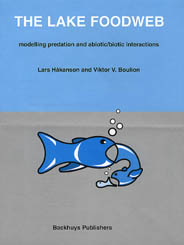

The book presents the Lake Webmodel, a general model to quantify all important lake foodweb interactions, including biotic/abiotic feedbacks. The model has been critically tested against very comprehensive empirical data sets mainly from Eastern and Western Europe, including many new empirical models. Lake Web includes the key functional groups of organisms: phytoplankton, bacterioplankton, benthic algae, macrophytes, zoobenthos, herbivorous and predatory zooplankton, prey fish and predatory fish. The model is based on many new approaches of structuring lake foodweb interactions. It uses ordinary differential equations and gives weekly variations in production and biomass for its nine groups of organisms. The model also includes a new mass-balance model for phosphorus and new approaches to quantify suspended particulate matter and the depth of the photic zone. Funamental concepts include consumption rates, metabolic efficiency ratios, distribution coefficients, migration of fish and predation pressure. An important feature of LakeWeb is that it can be run by just a few driving variables readily accessible from standard maps and monitoring programs. Several scenarios describe how the model can be applied to address important management issues, like consequences of biomanipulations (fish kill catastrophes), changes in land-use (eutrophication and humification), acidification and global temperature changes. LakeWeb is a powerful tool to simulate such measures and to get realistic expectations of positive and negative consequences of remedial measures. The present version of LakeWeb has been tested for lakes smaller than 300 km2, but many of the structural components should be valid also for larger systems, e.g., for coastal areas (like the Baltic or Norwegian fjords), or the large lakes of the world (like Great Lakes of America, the Caspian Sea or Lake Ladoga).
In spite of the fact that there exist many good textbooks in Ecosystem analysis, Ecosystem modelling, Limnology and other Aquatic sciences there is none which gives the holistic, general approach of this book. So, it ought to attract a considerable interest from researchers and students in Ecology, Biology, Geosciences and Environmental engineering, as well as from consultants and administrators interested in management and studies of aquatic ecosystems.
Acknowledgements.
Prologue.
1. Introduction and aim.
2. Fundamental relationships and classification of lakes.
2.1. Definitions of key concepts of the lake foodweb.
2.2. Lake classification systems.
2.3. Lake morphometric parameters.
2.4. The state variables - total-P, pH and lake colour.
2.5. Sedimentological concepts used in LakeWeb.
2.6. Concluding comments.
3. Model structuring and testing.
3.1. Introduction and aim.
3.2. Model set-up.
3.3. Critical model tests.
3.4. Set-up of model tests and calibrations.
3.5. Target variables in LakeWeb.
3.6. Panel of driving variables.
4. The mass-balance model for phosphorus.
4.1. Introduction to lake phosphorus modelling.
4.2. Model description.
4.3. Sensitivity and uncertainty tests.
4.4. A practical application scenario – effects of emissions from fish
farms.
4.5. Concluding remarks.
5. LakeWeb.
5.1. Introduction and aim.
5.2. Phytoplankton and bacterioplankton.
5.3. Macrophytes.
5.4.Benthic algae and zoobenthos.
5.5. Zooplankton.
5.6. Fish.
5.7. Sensitivity and uncertainty tests of the LakeWeb-model.
6. Practical use of LakeWeb.
6.1.
Introduction and aim.
6.2. Target variables for lake management.
6.3. Biomanipulation.
6.4. Lumbering operations and lake humification – Lake Stora
Kröntjärn, Sweden.
6.5. Changes in agriculture and oligotrophication
– Lake Batorino, Belarus.
6.6. “Global change”, changes in temperature regime – Lake Batorino,
Belarus.
6.7. Eutrophication and biomanipulation from fish farm emissions - Lake S. Bullaren,
Sweden.
6.8. Consequences and correctives related to acidification
– Lake Huljesjön, Sweden.
6.9. Comments.
7. Epilogue.
8. Literature references.
9. Appendices.
9.1. Data on gram wet weight and dry weight for different species of plankton.
9.2. Chlorophyll concentrations and total number of bacteria.
9.3. Data on pH, lake colour and phytoplankton biomass.
9.4. Data on the relationship between Secchi depth and suspended particulate
matter.
9.5. Data on biomasses and production values of herbivorous
and predatory zooplankton and primary latitude and phytoplankton
production.
9.6. A compilation of all equations of the LakeWeb-model with values for the
default lake.
Index.